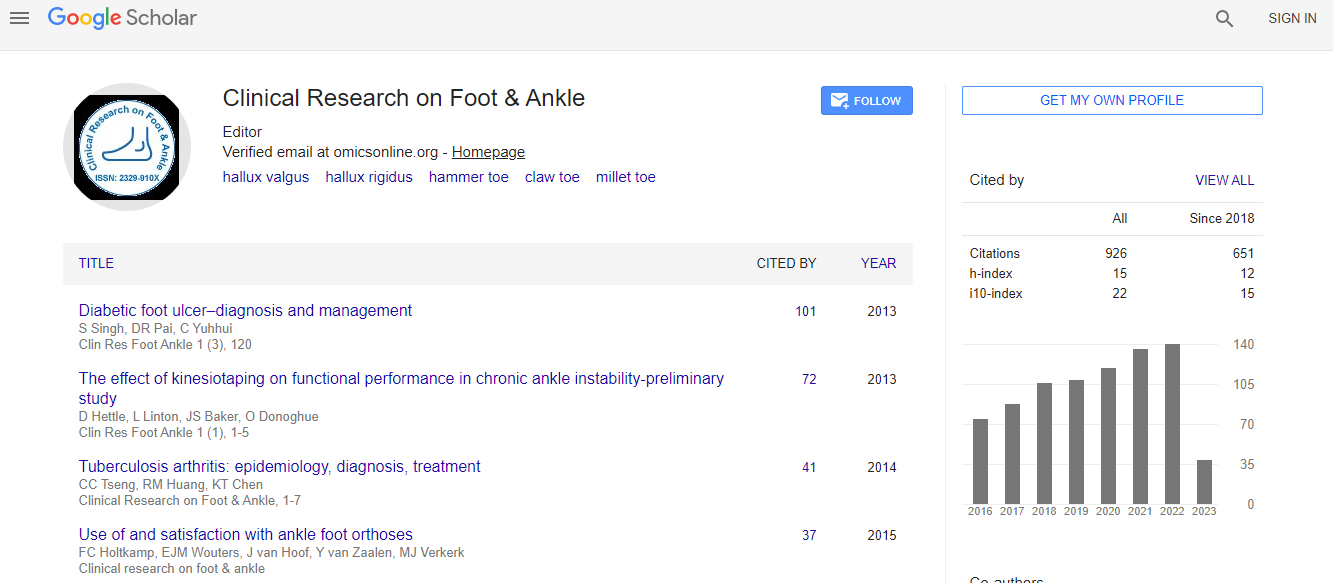Research Article
Foot and Ankle Fracture Incidence in South-Eastern Australia: An Epidemiological Study
| Kara L Holloway1*, David M Moloney1, Sharon L Brennan1,2,3, Mark A Kotowicz1,2,4, Gosia Bucki-Smith1, Elizabeth N Timney1, Amelia G Dobbins1 and Julie A Pasco1,2,4 | ||
| 1School of Medicine, Deakin University, 285 Ryrie Street, Geelong, VIC 3220, Australia | ||
| 2NorthWest Academic Centre, Department of Medicine, The University of Melbourne, C/- Sunshine Hospital, 176 Furlong Rd., St Albans, VIC 3021, Australia | ||
| 3Australian Institute for Musculoskeletal Sciences, The University of Melbourne, C/- Sunshine Hospital, 176 Furlong Rd., St Albans, VIC 3021, Australia | ||
| 4Barwon Health, Ryrie Street, Geelong, VIC 3220, Australia | ||
| Corresponding Author : | Dr. Kara Holloway Epi-Centre for Healthy Ageing, School of Medicine Deakin University, C/- Kitchener House, Barwon Health PO Box 281,Geelong, VIC 3220, Australia Tel: +61 0448811425 Fax: +61 0342153491 E-mail: KHOLLO@BarwonHealth.org.au |
|
| Received July 23, 2014; Accepted July 27, 2014,; Published July 31, 2014 | ||
| Citation: Holloway KL, Moloney DM, Brennan SL, Kotowicz MA, Bucki-Smith G, et al. (2014) Foot and Ankle Fracture Incidence in South-Eastern Australia: An Epidemiological Study. Clin Res Foot Ankle 2:148. doi:10.4172/2329-910X.1000148 | ||
| Copyright: © 2014 Halloway KL, et al. This is an open-access article distributed under the terms of the Creative Commons Attribution License, which permits unrestricted use, distribution, and reproduction in any medium, provided the original author and source are credited. | ||
Related article at Pubmed Pubmed  Scholar Google Scholar Google |
||
Abstract
Objective: The aim of this study was to report the incidence of all foot and ankle fractures during 2006 and 2007 among residents from the Barwon Statistical Division, located in south-eastern Australia.
Methods: Incident fractures were ascertained using X-ray reports from the imaging centres serving the region during the years 2006 and 2007. All fractures with ICD-9 code 824 (ankle) or 825 (foot) were included in this study. Age, proportions of left/right side fractures, cause of fracture and incidence rates (per 10,000 person-years) were all determined for foot and ankle fractures separately as well as for the two sites combined.
Results: There were 312 males and 274 females identified with foot fractures and 344 males and 410 females with ankle fractures. The median age for both foot and ankle fracture was lower in males compared to females. The proportions of left and right side fractures were approximately equal; no sex or site (foot or ankle) showed higher proportions of either left or right side fractures. Among those for whom cause of fracture was known, most foot or ankle fractures (>75%) in both sexes were caused by an accidental fall. For both sexes, there was a bimodal pattern of incidence across the age groups, with peaks around adolescence/early adulthood and in the elderly. Incidence rates (per 10,000 person-years) for foot and ankle fractures combined were similar in both sexes; 25.85 and 25.88 for males and females, respectively. However, the incidence rate for foot/ankle fractures combined in those aged 50 years or over was lower in males than in females.
Conclusion: Males sustained foot and ankle fractures at a lower median age than females and most fractures were the result of an accidental fall. Males sustain fractures mainly during adolescence and young adulthood, whereas fractures in females were sustained largely by individuals over 50 years of age. Despite this, the overall incidence rates were similar for both sexes.

 Spanish
Spanish  Chinese
Chinese  Russian
Russian  German
German  French
French  Japanese
Japanese  Portuguese
Portuguese  Hindi
Hindi 
